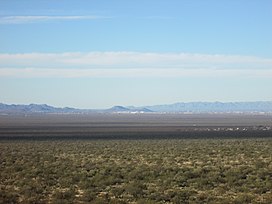| Tumamoc Hill | |
|---|---|
 View across the Tucson Basin towards Tumamoc Hill (left) and "A" Mountain (center) | |
| Highest point | |
| Prominence | 3,108 ft (947 m) |
| Coordinates | 32°12′46″N 111°00′22″W / 32.21278°N 111.00611°W |
| Naming | |
| Etymology | from Tohono O'odham Cemamagĭ Doʼag 'Horned lizard mountain'[1][2] |
| Geography | |
| Parent range | Tucson Mountains |
Tumamoc Hill (O'odham: Cemamagĭ Doʼag Horned lizard mountain) is a butte[3] located immediately west of "A" Mountain and downtown Tucson, Arizona. It is home to many radio, television, and public safety transmitters. The 860-acre ecological reserve and U.S. National Historic Landmark was established by the Carnegie Institution in 1903.[4] The University of Arizona (UA) owns a 340-acre (1.4 km2) preserve and leases another 509 acres (2.06 km2) as a research and education facility. The Steward Observatory maintains a small astronomical observatory with a 20-inch (510 mm) telescope on the hill. Besides being a prominent landmark, Tumamoc Hill has a long and varied history, and is currently an important site for ecological and anthropological research as well as a refuge and a recreational option for the people of Tucson. Part of the University of Arizona, the Desert Laboratory is located on Tumamoc.[5]
- ^ Mathiot, Madeleine (1973). A Dictionary of Papago Usage. Vol. 1: B-K, Vol. 2: L-Z. Bloomington, IN: Indiana University. ISBN 9780877501688.
- ^ Saxton, Dean; Saxton, Lucille; Enos, Susie (1983). Tohono O'odham/Pima to English, English to Tohono O'odham/Pima Dictionary. Tucson, AZ: The University of Arizona Press. ISBN 978-0-8165-1942-2.
- ^ "Ongoing Field Research at Tumamoc Hill" (PDF). UofA Desert Laboratory. Retrieved 2013-12-07.
- ^ Mace, Mikayla. "New director of Tumamoc Hill lab has big plans for research center, community landmark". Arizona Daily Star. Retrieved 2018-10-03.
- ^ "Home | Desert Laboratory on Tumamoc Hill". tumamoc.arizona.edu. Retrieved 2023-01-16.
